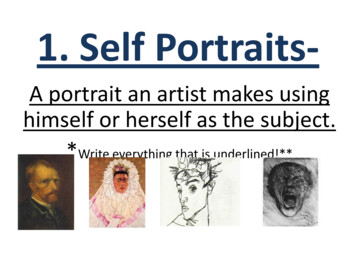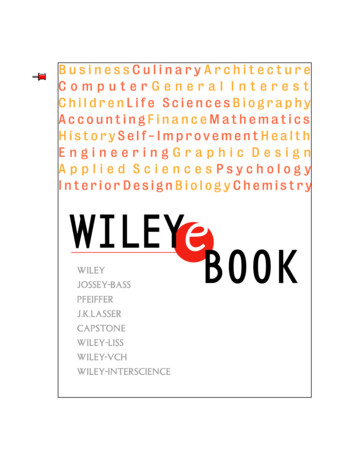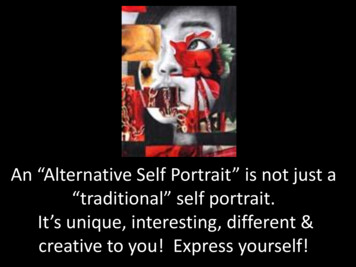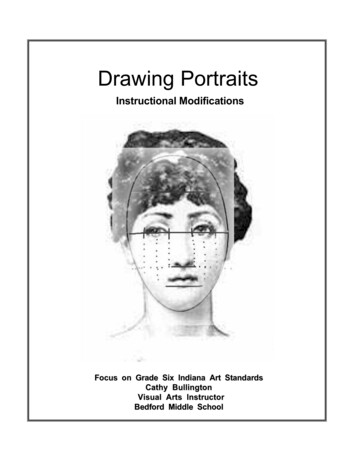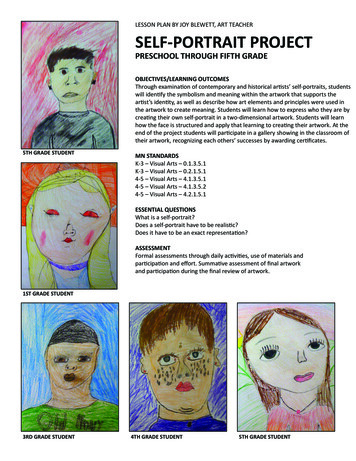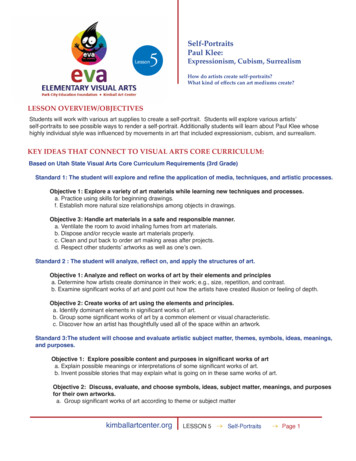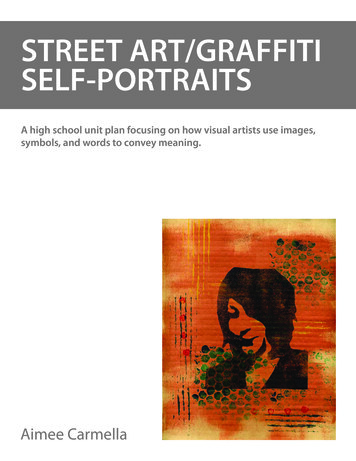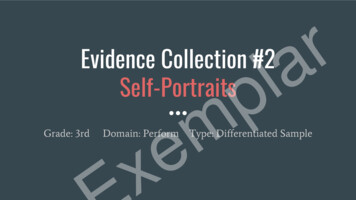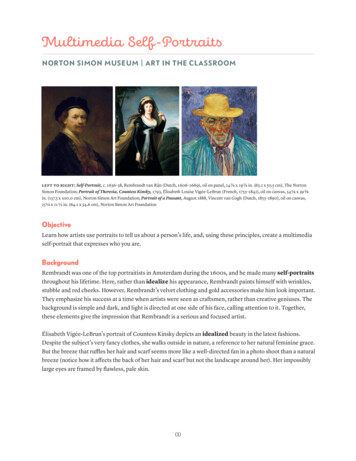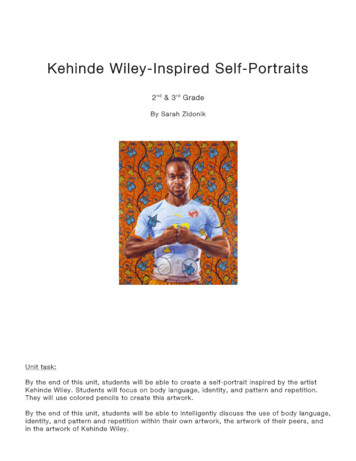
Transcription
Kehinde Wiley-Inspired Self-Portraits2 nd & 3 rd GradeBy Sarah ZidonikUnit task:By the end of this unit, students will be able to create a self-portrait inspired by the artistKehinde W iley. Students will focus on body language, identity, and pattern and repetition.They will use colored pencils to create this artwork.By the end of this unit, students will be able to intelligently discuss the use of body language,identity, and pattern and repetition within their own artwork, the artwork of their peers, andin the artwork of Kehinde W iley.
Session # 1Standards:VA3: Students will respond critically to a variety of works in the arts, connecting theindividual work to other works and to other aspects of human endeavor and thought.Focus of Instruction (Objective):I can discuss body language and identity, using the artwork of Kehinde W iley as a startingpoint.Introduction: Let students know we will be beginning a new unit inspired by the artistKehinde W iley and his paintings of people (portraits). Have several printouts of im ages ofW iley’s paintings ready to pass around the class. Ask students to share what they noticeabout these im ages. This can be done in a whole class discussion.Next let students know that we will be focusing on the elements of body language andidentity to com e up with our ideas for this unit. Break down the words together to figure outtheir meanings. Sum m arize our discussion by emphasizing that body language means tospeak with your body and not with words and this includes your facial expressions, and thatidentity m eans who we are. Show a couple of exam ples of body language with your ownbody, and then have a few student volunteers think of a personality trait or em otion toexpress to the class through a body language pose. Classm ates can respond by “reading”this pose. If students cannot think of an emotion or a trait to express, have a bank prepared(at least in your m ind) to whisper to the students who volunteer.Direct Instruction: Next let the students know that we will be breaking down into sm allerdiscussion groups at our tables to exam ine the paintings of Kehinde W iley more closely.Guide students to focus their discussion on reading the body language (including facialexpressions) of the subject of each portrait. They should then use that inform ation to drawconclusions about that person’s identity, or at least what the artist wants us to think aboutthat person’s identity. Use a student volunteer or two to demonstrate how a conversationabout a specific painting m ay unfold.Let students know that we are having this discussion so that we m ay create our own,informed self-portraits using body language to express som ething about our own identities.Also let them know that you will be photographing them in a pose in the next class so thatwe can learn to draw from a photograph, just like Kehinde W iley paints from a photograph.Independent work: Students will work in sm all groups using printouts of Kehinde W iley’spaintings to discuss body language and identity. W alk around to take note of student’sprogress and to guide them in the right direction.Session # 2Standards:VA3: Students will respond critically to a variety of works in the arts, connecting theindividual work to other works and to other aspects of human endeavor and thought.
VA1(b): Students will develop their own ideas and im ages through the exploration andcreation of art works based on them es, sym bols, and events.Focus of Instruction (Objective):I can learn about the artist Kehinde W iley by critically watching a video docum entary abouthis work. I can focus on the ways he poses his models to express specific things.I can pose for a picture using body language to express som ething about my identity, and Ican sum m arize this part of m y identity in one word.Introduction: Let students know we will be watching a PBS docum entary about the artistKehinde W iley. This video shows the artist getting ready for a specific show entitled AnEconom y of Grace. It begins by showing the artist selecting models on the streets of NewYork, preparing the wardrobe for the models, photographing the models in specific poses(em phasizing body language!), and then finally painting them.Also let students know that while they are watching the video and considering how KehindeW iley utilizes body language to express identity in his artwork, they will also have to posetoday in a body language pose of their choice to depict or express their own identities.Direct Instruction: Before the video begins, have a few students demonstrate how to expressspecific personality traits (i.e. “Solom on, please dem onstrate how you could express that youare a silly person.” Or “Akeil, please show us a body language pose if you wanted to expressa serious side of your identity.”) Once the video begins, for the first several minutes, pause inkey parts to make comments to help guide the students’ thoughts while watching. Certainclasses m ay be able to take notes to help focus their m inds during the video while othersmay struggle too m uch with writing for this to be helpful.Independent work: For the rem ainder of this period, students should be taken aside one byone to pose for their body language portrait. Remind them that this is the photograph thatwill be printed and that we will be drawing from. Before they pose, ask them what they wouldlike to express about their identity through this pose in one word (angry, happy, strong, etc.).Record what they tell you on a class list.It is best to take photographs at this stage even though they will be working on theirbackgrounds first, because you want to be sure to have a photograph for each student oncewe begin to draw from the photograph (som e students m ay not be present on this particularday, for exam ple, and you will have to take their photo in the next couple classes).Session # 3Standards:VA3: Students will respond critically to a variety of works in the arts, connecting theindividual work to other works and to other aspects of human endeavor and thought.VA1(b): Students will develop their own ideas and im ages through the exploration andcreation of art works based on them es, sym bols, and events.
VA1(a): Students will experim ent and create art works, in a variety of m edium s (drawing,painting, sculpture, ceram ics, printm aking, video, and com puter graphics), based on a rangeof individual and collective experiences.Focus of Instruction (Objective):I can discuss the backgrounds in Kehinde W iley’s artwork.I can begin to draw m y own patterned wallpaper background for a Kehinde W iley-inspiredself-portrait using sym bols and repetition.Introduction: Let students know that for this unit there are two m ain parts: the backgroundand the drawing of ourselves. W e will create them separately and then glue the cut-outdrawing of ourselves to our background once both pieces are com plete (show an exam ple ofhow this works). The reason why we are creating them separately is so that we can create acontinuous, repetitive pattern, m uch like the “wallpaper-like” backgrounds of Kehinde W iley’spaintings.Ask students to exam ine the backgrounds of Kehinde W iley’s paintings as a whole class.o W hat do you notice in the backgrounds of his work (what IS a background?!)?o W hat do you think W iley is trying to express by putting together these backgroundswith these particular people?o Or what do these patterns m ean to you? How would you describe them ?Direct Instruction: Let students know that we will be using Kehinde W iley’s use of apatterned background to inspire our own backgrounds. Our backgrounds, however, shoulduse thoughtful sym bols that help express our identities further. W hat is a sym bol? And whatsym bols m ight you want to use in your own background?Dem onstrate how you m ight create your own patterned background by repeating sym bolsthat represent your identity, who you are. (For my example I used a paintbrush to symbolizethat I am an artist.) Draw out the entire background with pencil first, then we will color thesym bols with colored pencils, and paint the in-between spaces with tem pera cakes. (Showan exam ple.)Independent work: Students will begin draw their own patterned backgrounds by repeatingsym bols that represent them selves.Session # 4Standards:VA1(a): Students will experim ent and create art works, in a variety of m edium s (drawing,painting, sculpture, ceram ics, printm aking, video, and com puter graphics), based on a rangeof individual and collective experiences.VA1(b): Students will develop their own ideas and im ages through the exploration andcreation of art works based on them es, sym bols, and events.VA1(d): Students will reveal through their own art work understanding of how art m edium sand techniques influence their creative decisions.
Focus of Instruction (Objective):I can draw the symbols for m y own patterned wallpaper background for a Kehinde W ileyinspired self-portrait using sym bols and repetition.Introduction: Let students know that we will be drawing our backgrounds to our KehindeW iley-inspired self-portraits over the next couple classes. Once the sym bols are drawn andcolored in, we will paint the space in-between them with tem pera cakes (show exam ple).Direct Instruction: At this point it is a good idea to show pointers specific to problem s orissues that m ay arise as you see them to each particular class. Most classes could use adem onstration of how to color in neatly with colored pencils (go in different directions anduse sm all/short lines rather than large “scribbles” to fill in your sym bols.)Independent work: Students continue to draw and color their repeated sym bols.Session # 5Standards:VA1(a): Students will experim ent and create art works, in a variety of m edium s (drawing,painting, sculpture, ceram ics, printm aking, video, and com puter graphics), based on a rangeof individual and collective experiences.VA1(b): Students will develop their own ideas and im ages through the exploration andcreation of art works based on them es, sym bols, and events.VA1(d): Students will reveal through their own art work understanding of how art m edium sand techniques influence their creative decisions.Focus of Instruction (Objective):I can paint around m y sym bols on m y background using a small brush and tempera cakes.Introduction: Let students know we should finish our backgrounds today by painting in thespaces around our drawn sym bols with a sm all brush.Direct Instruction: Dem onstrate how to use a sm all brush to paint in sm all spaces (betweensym bols previously drawn). Also give each student a paper towel, and dem onstrate how todab away areas if they becom e too wet or if the paint gets in undesired areas. If too m uchpaint gets in an undesired area, show students how to “erase” the paint by adding cleanwater from a clean brush to the area and picking it up by dabbing with the paper napkin (tryto have softer napkins available versus the school paper towels, as the school paper towelsare less absorbent and m ay just spread the problem areas further).Independent work: Students will paint their backgrounds.Session # 6-7Standards:
VA1(a): Students will experim ent and create art works, in a variety of m edium s (drawing,painting, sculpture, ceram ics, printm aking, video, and com puter graphics), based on a rangeof individual and collective experiences.VA1(b): Students will develop their own ideas and im ages through the exploration andcreation of art works based on them es, sym bols, and events.VA1(d): Students will reveal through their own art work understanding of how art m edium sand techniques influence their creative decisions.Focus of Instruction (Objective):I can draw my body-language self-portrait using m y photograph as a stencil.Introduction: Let students know that we will be drawings ourselves in the next couple classesusing our photographs as a stencil and then as guidance for details. (Make sure to havephotographs pre-cut if you do not want a particular class to use scissors.)Direct Instruction: Dem onstrate how to use a cut-out photograph of a student to trace onto awhite piece of paper. Little pieces of tape are helpful to keep the paper in place as you trace.Once you have com pletely traced the photo, rem ove the tape and m ove the photo around tomark where inside details belong (hold to the side to m ark where the shirt ends or where theeyes belong, for exam ple). Then start to add further details, and color with colored pencils.Also dem onstrate how a student could add their own creative details that are not present inthe photograph (such as a tutu or a new hair-do).Independent work: Students will work independently to draw them selves using their photo.Purposeful share: Have students turn and talk during the last 5 minutes of class to sharewhat they have done so far. W hat did you notice when tracing your photo? W hat problem sarose for you during the drawing? Did your partner have the sam e problem s? Or advice?Session # 8:Standards:VA1(a): Students will experim ent and create art works, in a variety of m edium s (drawing,painting, sculpture, ceram ics, printm aking, video, and com puter graphics), based on a rangeof individual and collective experiences.VA1(d): Students will reveal through their own art work understanding of how art m edium sand techniques influence their creative decisions.Focus of Instruction (Objective):I can arrange my self-portrait on the background where I think it works best. (Some classeswill be able to cut out their portrait to glue onto the background while others m ay need theteacher to do so ahead of tim e for them.)
Introduction: Gather students together to discuss what we will be doing today. Let themknow that we need to complete this unit by gluing our cut-out drawings of ourselves onto ourpattern background.Direct Instruction: Dem onstrate how you can m ove your picture drawing around thebackground until it “looks right” to you. Once you have found the best location, dem onstratehow to correctly glue it down using a glue stick.Independent work: Students will finish up any loose ends to their project and then glue downtheir pictures onto their backgrounds.Purposeful Share: W e will gather as a whole class or in separate groups by tables (dependingon the class and the am ount of tim e left) to discuss our m asterpieces.Critique cards can be used for guidance but only if there is enough tim e. (See attachment)
Kehinde W iley: Body Language Self-Portraits Grading Rubric4321Final project:Final project:Final project:Final project: clearly demonstratesan understanding ofbody language toexpress identity, andstudent is able toarticulate themeaning behind thechosen bodylanguage pose.clearly made use ofthe photo as astencil to trace theshape of your bodyand then to markwhere importantdetails belong.Uses a repetition ofsymbols to create ameaningful“wallpaper”background.Is carefully andcompletely coloredin and paintedStudent has clearlytaken ownership andmade individual choicesto move beyond thebare minimum. demonstrates anunderstanding ofbody language toexpress identity, andstudent is able toarticulate themeaning behind thechosen bodylanguage pose.made use of thephoto as a stencil totrace the shape ofyour body and thento mark whereimportant detailsbelong.Uses a repetition ofsymbols to create a“wallpaper”background.Is carefully andcompletely coloredin and painted demonstrates an understanding ofbody language toexpress identity.Partially made use of the photo as astencil to trace theshape of your body.Uses a repetition ofsymbols to create a“wallpaper” background, thoughsymbols hold littlemeaning.Is not carefully andcompletely coloredin and painted. Does notdemonstrate anunderstanding ofbody language toexpress identity.Partially or hardlymade use of thephoto as a stencil totrace the shape ofyour body.Does not use arepetition of symbolsto create a“wallpaper”background, orsymbols hold nomeaning.Is not carefully andcompletely coloredin and painted.
Kehinde Wiley Self-AssessmentAsk yourself these questions to make sure you remembered everything!Did you ü choose a body language pose that tell us som ething about who you are (your identity)?ü use your photo as a stencil to trace the shape of your body and then to m ark whereimportant details belong?ü thoughtfully choose sym bols in your background that help us understand your identityeven m ore?ü use repetition of these symbols to create a pattern in the background?ü carefully and com pletely color in and/or paint your self-portrait (both the backgroundand your body)?ü take your tim e and com pletely finish the assignm ent?Kehinde Wiley Self-AssessmentAsk yourself these questions to make sure you remembered everything!Did you ü choose a body language pose that tell us som ething about who you are (your identity)?ü use your photo as a stencil to trace the shape of your body and then to m ark whereimportant details belong?ü thoughtfully choose sym bols in your background that help us understand your identityeven m ore?ü use repetition of these symbols to create a pattern in the background?ü carefully and com pletely color in and/or paint your self-portrait (both the backgroundand your body)?ü take your tim e and com pletely finish the assignm ent?
Questions to ask your partner and yourself BEFORE you complete your background:ü Do you have sym bols that express your identity (who you are)?ü If no, what symbols will you add today?ü How much space is left blank on your paper? W hat size symbols do you think is bestat this point to be able to com plete the assignm ent?ü Did you repeat your symbols to create a pattern in your background?Questions to ask your partner and yourself BEFORE you com plete your background:ü Do you have sym bols that express your identity (who you are)?ü If no, what symbols will you add today?ü How much space is left blank on your paper? W hat size sym bols do you think is bestat this point to be able to com plete the assignm ent?ü Did you repeat your sym bols to create a pattern in your background?Questions to ask your partner and yourself BEFORE you com plete your background:ü Do you have sym bols that express your identity (who you are)?ü If no, what symbols will you add today?ü How much space is left blank on your paper? W hat size symbols do you think is bestat this point to be able to com plete the assignm ent?ü Did you repeat your sym bols to create a pattern in your background?Questions to ask your partner and yourself BEFORE you com plete your background:ü Do you have sym bols that express your identity (who you are)?ü If no, what symbols will you add today?ü How much space is left blank on your paper? W hat size symbols do you think is bestat this point to be able to com plete the assignm ent?ü Did you repeat your sym bols to create a pattern in your background?Questions to ask your partner and yourself BEFORE you com plete your background:ü Do you have sym bols that express your identity (who you are)?ü If no, what symbols will you add today?ü How much space is left blank on your paper? W hat size symbols do you think is bestat this point to be able to com plete the assignment?ü Did you repeat your sym bols to create a pattern in your background?Questions to ask your partner and yourself BEFORE you com plete your background:ü Do you have sym bols that express your identity (who you are)?ü If no, what symbols will you add today?ü How much space is left blank on your paper? W hat size symbols do you think is bestat this point to be able to com plete the assignm ent?ü Did you repeat your sym bols to create a pattern in your background?
Critique Cards:Best CRAFTSMANSHIPCraftsman:noun, plural craftsmen.1.a person who practices oris highly skilled in a craft; artisan.2. an artist.Let someone know that you notice howcarefully they completed this artwork!They took their time, practiced arttechniques, and completely finished theassignment.Give the artist an intelligentcompliment! AND EXPLAIN WHYAsk yourself before you speak:Did the artist follow the unit guidelines?(What WERE the unit guidelines?!)How did the artist take ownership of theassignment to make it his/her ownartwork?What part(s) do you see as exceptionaland why?How does this artwork make you feel?Ask the artist an intelligent question!Example starters:Why did you choose to ?What was your inspiration for ?How did you ?If you could change something aboutyour artwork, what would it be?What is your favorite part about thisartwork and why?What does mean to you?How does this artwork make you feel?
Kehinde Wiley-Inspired Self-Portraits 2nd & 3rd Grade By Sarah Zidonik Unit task: By the end of this unit, students will be able to create a self-portrait inspired by the artist Kehinde Wiley. Students will focus on body language, identity, and pattern and repetiti
